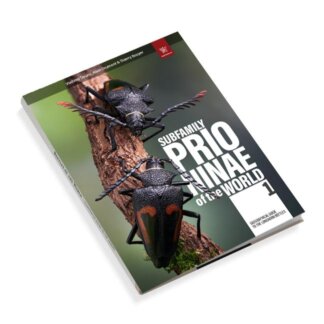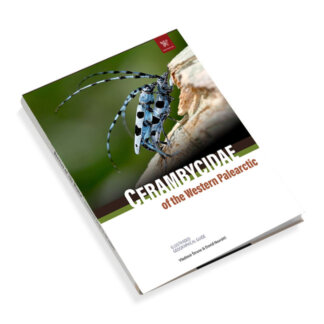Fleas
Order Siphonaptera, Insect
Book novelties:
Prioninae of the World I.
Cerambycidae of the Western Paleartic I.
Book about Beetles
Buy now. List of family Coleoptera
You can find here: Carabidae, Buprestidae, Cerambycidae, Cicindelidae, Scarabaeidae, Lucanidae, Chrysomelidae, Curculionidae, Staphylinidae
Books about Beetles
Unique pictorial atlases for identifying Beetles:
(2020) Tiger Beetles of the World, Cicindelidae, Illustrated guide to the genera
(2023) Tiger Beetles of Africa, Cicindelidae, Geographical guide to the family Cicindelidae
(2024) Tiger Beetles of Orient, Cicindelidae, Geographical guide to the family Cicindelidae
(2022) Ground Beetles of Africa, Afrotropical Region
(2022) Jewel Beetles of the World, Buprestidae, Illustrated guide to the Superfamily Buprestoidea
(2008) The Prionids of the World, Prioninae, Illustrated catalogue of the Beetles
(2010) The Prionids of the Neotropical region, Prioninae, Illustrated catalogue of the Beetles
Order Siphonaptera, Insect
Siphonaptera, commonly known as fleas, are small, wingless insects that belong to the order of insects characterized by their ability to jump. This order comprises approximately 2,500 species, with the most notable being the cat flea (Ctenocephalides felis) and the dog flea (Ctenocephalides canis). Fleas are ectoparasites, primarily feeding on the blood of mammals and birds, which makes them significant in the study of parasitology and veterinary entomology.
Siphonaptera
Fleas have a unique morphology that aids in their parasitic lifestyle. Their bodies are laterally compressed, allowing them to navigate through the fur of their hosts with ease. Adult fleas possess specialized mouthparts adapted for piercing skin and sucking blood, while their powerful hind legs enable them to jump distances up to 200 times their body length. This remarkable jumping ability is facilitated by a unique structure known as the resilin, a protein that acts like a spring.
The life cycle of fleas consists of four stages: egg, larva, pupa, and adult. Female fleas can lay up to 50 eggs per day, which can quickly lead to infestations. The eggs are typically deposited in the host’s environment, such as bedding or carpets, where they hatch into larvae. These larvae are not blood-feeding; instead, they consume organic debris, including adult flea feces, which contains undigested blood. The larvae then pupate, and under favorable conditions, adults emerge within a week. However, in adverse conditions, they can remain in the pupal stage for several months, waiting for a suitable host to come near.
Fleas are not only a nuisance but also vectors for various diseases. They can transmit pathogens such as the bacteria responsible for bubonic plague (Yersinia pestis) and murine typhus. Additionally, fleas can cause allergic reactions in both humans and animals, leading to conditions such as flea allergy dermatitis (FAD). This highlights the importance of effective flea control measures in both domestic and wild animal populations.
Control strategies for fleas typically involve a combination of environmental management and chemical treatments. Regular vacuuming and washing of pet bedding can significantly reduce flea populations in the home. Insect growth regulators (IGRs) and adulticides are commonly used to target different life stages of fleas. It is essential to consult with a veterinarian for appropriate treatment options, especially for pets that may have sensitivities to certain chemicals. Order Siphonaptera, Insect
In conclusion, Siphonaptera represents a diverse and ecologically significant group of insects. Understanding their biology, life cycle, and the diseases they can transmit is crucial for effective management and control. Continued research in entomology is necessary to develop innovative strategies for flea control and to mitigate their impact on both human and animal health.
Advantages and Disadvantages of Order Siphonaptera (Fleas)
Advantages
Specialized Adaptations for Parasitism
Blood-feeding mouthparts: Piercing-sucking structures enable efficient feeding on host blood.
Jumping ability: Hind legs are modified for powerful leaping (up to 50× body length), aiding host colonization.
Host retention: Tarsal claws and laterally flattened bodies prevent dislodgment from hosts.
Silk production: Larvae use silk glands to construct protective cocoons, enhancing survival.
Evolutionary Success
Holometabolous development: Complete metamorphosis (egg, larva, pupa, adult) ensures adaptability to diverse environments.
Global distribution: ~2,500 species thrive worldwide, exploiting mammals and birds as hosts.
Ecological Role
Disease vectors: Transmit pathogens (e.g., plague, typhus), influencing host populations and ecosystems.
Disadvantages
Host Dependency
Parasitic lifestyle: Fleas rely entirely on hosts for survival, limiting their ecological flexibility.
Vulnerability to host defenses: Host grooming or immune responses can reduce flea populations.
Reproductive Constraints
Indirect egg-laying: Eggs fall from hosts into nests/dens, risking desiccation or predation.
Pupal dormancy: Adults may remain in cocoons for months, delaying host colonization.
Taxonomic Limitations
Narrow evolutionary relationships: Closest relatives are Diptera and Mecoptera, limiting genetic diversity.
Secondary wing loss: Loss of flight restricts dispersal compared to winged insects


